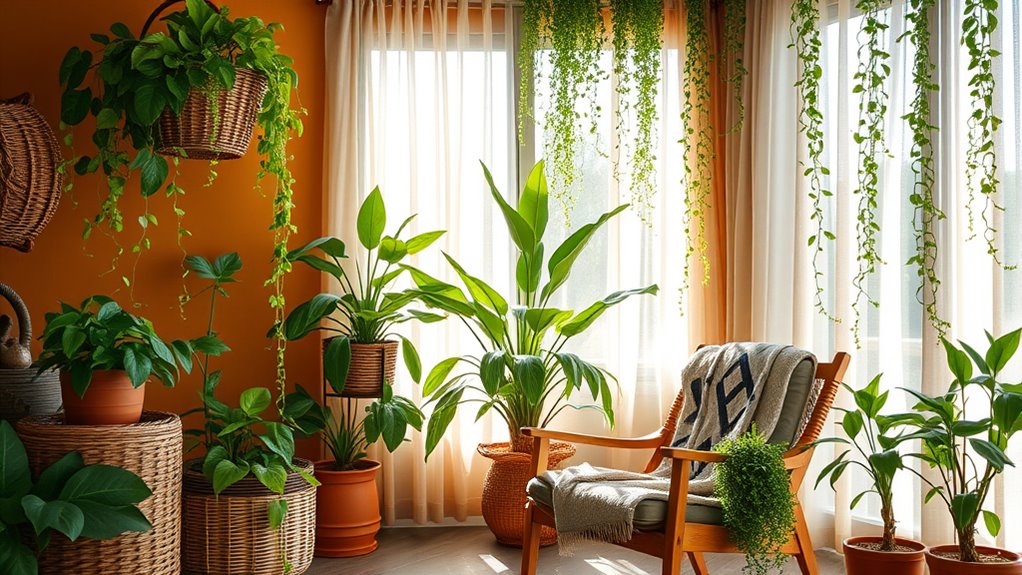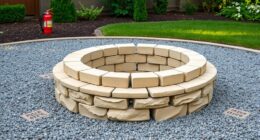A biophilic palette brings nature into your space by using earthy colors like greens, browns, and neutrals, creating a calming and authentic atmosphere. Incorporate natural materials such as reclaimed wood, stone, and textured fabrics to add tactile warmth. Integrate indoor plants and water features to enhance your environment’s tranquility. Focus on maximizing natural light and views to connect with the outdoors. Keep exploring to discover how these elements work together for a truly harmonious space.
Key Takeaways
- Use earthy, muted tones like greens, browns, and neutrals to create an organic color scheme.
- Incorporate natural materials such as reclaimed wood, stone, and textured fabrics to evoke nature.
- Select organic shapes and biomorphic patterns that mimic natural forms and flow.
- Integrate indoor plants and water elements to enhance biophilic aesthetics and promote well-being.
- Maximize natural light and outdoor views through strategic window placement and reflective surfaces.
Understanding the Principles of Biophilic Design

Have you ever wondered why certain spaces feel more calming and inviting than others? That’s often due to biophilic principles at work, which emphasize nature integration in design. These principles aim to reconnect you with the natural world, reducing stress and boosting well-being. By incorporating elements like natural light, organic shapes, and plant life, spaces become more engaging and soothing. Biophilic design isn’t just about aesthetics; it’s rooted in understanding how humans relate to nature. When you apply these principles, you create environments that foster comfort, creativity, and health. Incorporating natural elements seamlessly into interiors can make spaces feel alive and harmonious. Ultimately, understanding biophilic principles helps you craft spaces that truly nurture your senses and soul.
Selecting Nature-Inspired Color Schemes

Choosing the right color scheme is essential to creating a space that feels connected to nature. To achieve this, focus on color harmony by selecting shades that complement each other naturally. Start by choosing earthy tones like greens, browns, and soft neutrals, which evoke a calming, organic vibe. When it comes to shade selection, opt for muted or subdued hues rather than bright, overly saturated colors, as they promote relaxation and balance. Consider how different shades interact; pairing a sage green with warm beige or cool gray creates a cohesive, soothing environment. Keep in mind that subtle variations in tone can add depth without overwhelming the senses. Additionally, incorporating natural materials and textures can enhance the organic feel of your space. By carefully balancing color harmony and shade selection, you craft a space that feels both inviting and deeply rooted in nature’s palette.
Incorporating Natural Materials and Textures
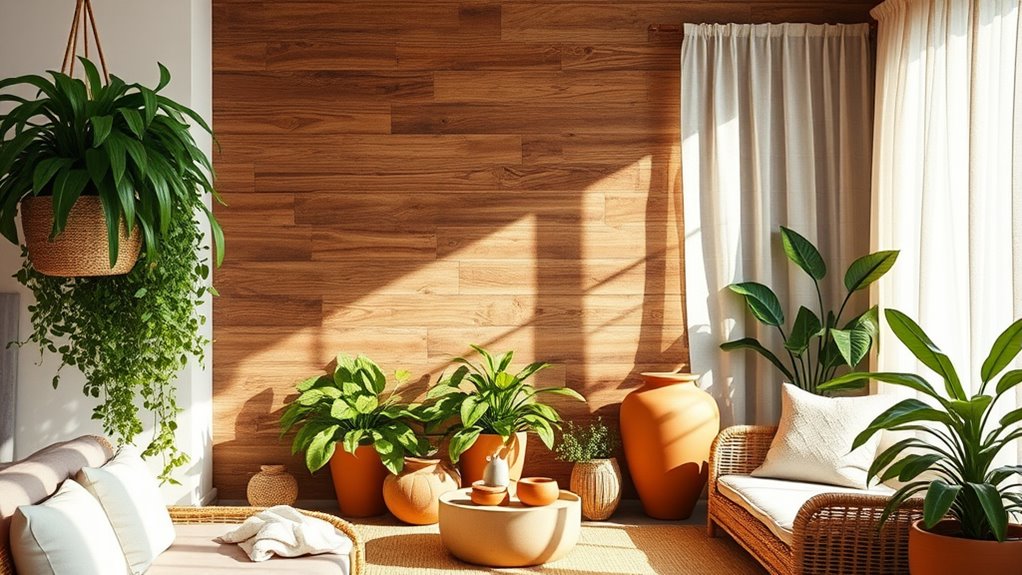
Building on the calming color palettes inspired by nature, integrating natural materials and textures enhances the organic feel of your space. Using textured fabrics like linen or burlap adds tactile interest, creating a cozy, inviting atmosphere. Reclaimed wood introduces warmth and sustainability, bringing an authentic, rustic charm. Incorporate natural stone or cork for variety and visual depth. Wicker or rattan furniture emphasizes organic textures, while clay or terracotta accessories deepen the earthy vibe. These elements not only elevate your decor but also promote a sense of harmony with nature. To create a truly biophilic environment, focus on authentic materials that age beautifully and connect you to nature’s timeless beauty. This approach fosters comfort and tranquility in your space. Additionally, selecting vetted materials that float on water can enhance durability and ease of maintenance in coastal or humid environments.
Using Plants to Enhance Indoor Environments
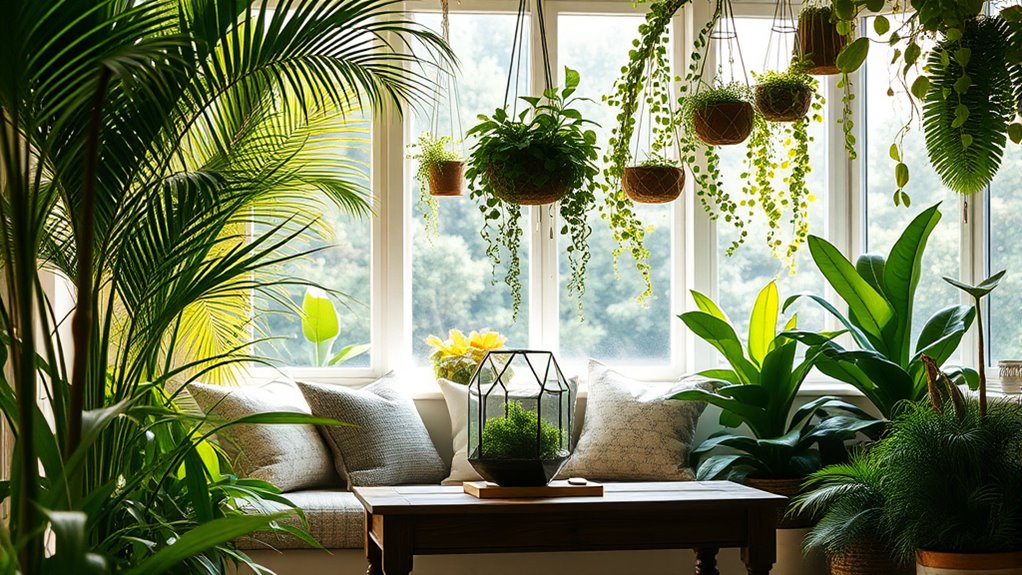
Incorporating plants into your indoor environment instantly boosts the space’s natural appeal and promotes well-being. Air purifying plants like snake plants, pothos, and peace lilies remove toxins, improving air quality and creating a healthier space. Vertical gardens offer a striking, space-efficient way to introduce greenery, especially in smaller areas. They add texture and visual interest while maximizing your plant display without cluttering surfaces. By choosing a variety of plants suited to your environment, you enhance the aesthetic and foster a calming atmosphere. Regular care ensures vibrant growth and continued air purification. Leveraging indoor gardening innovations can further optimize plant health and display. Integrating these elements transforms your indoor space into a more inviting, nature-inspired sanctuary, supporting both your health and your design goals.
Maximizing Natural Light and Views
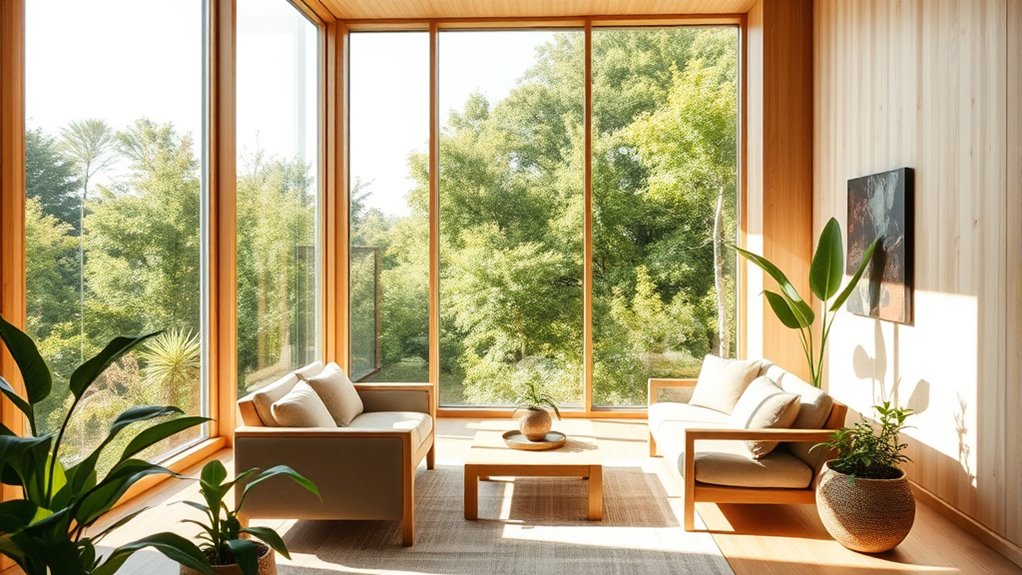
You can enhance natural light and views by thoughtfully placing your windows where they catch the most sun and overlook nature. Incorporating reflective surfaces like mirrors or glossy finishes helps bounce light deeper into your space. Using translucent materials for partitions or skylights also boosts brightness while maintaining a sense of openness. Additionally, selecting unique and wicked planters can complement your decor and further emphasize your connection to nature.
Optimal Window Placement
Maximizing natural light and views begins with strategic window placement that considers both orientation and proximity to outdoor scenery. To optimize sunlight and scenery, choose the right window size and style for each space. Larger windows bring in more light and offer expansive views, but balance them with energy efficiency. Position windows to face south or east to capture morning and afternoon sun, reducing shading needs. Consider window style—casement, picture, or sliding—to enhance views and control light flow. Proper placement also involves avoiding obstructions and aligning windows with outdoor features.
- Use wide, tall windows for panoramic views
- Incorporate operable styles for ventilation
- Avoid placing windows where glare is unavoidable
- Orient windows to maximize sunlight without overheating
- Balance window size to optimize light and privacy
Incorporating Reflective Surfaces
Strategic use of reflective surfaces can considerably amplify natural light and extend views within a space. Incorporate mirror accents to bounce sunlight deeper into the room, creating a brighter, more inviting environment. Reflective wall panels are another effective tool, as they not only enhance light but also visually expand the space, making it feel larger. Position these surfaces thoughtfully to reflect outdoor scenery or key architectural features, maximizing the connection with nature. Keep in mind that the goal is to brighten the space without causing glare or discomfort. By carefully selecting and placing mirror accents and reflective wall panels, you seamlessly bring in more natural light and views, fostering a calming, biophilic atmosphere rooted in the regional flavors and traditions.
Using Translucent Materials
Translucent materials serve as a powerful tool to enhance natural light and create seamless views of the outdoors. By incorporating translucent paneling or frosted glass, you can diffuse sunlight, reducing glare while maintaining privacy. This approach opens up spaces, making rooms feel larger and more connected to nature. Use frosted glass in interior partitions or sliding doors to blur boundaries between indoor and outdoor environments. Translucent paneling can be applied to ceilings or walls, allowing light to filter evenly throughout the space. The result is a calming, naturally lit environment that promotes wellbeing. Additionally, choosing high-quality translucent materials can improve durability and light diffusion, ensuring long-term aesthetic and functional benefits.
- Increase privacy without sacrificing light
- Soften harsh sunlight for comfort
- Create visual connections to nature
- Enhance spatial openness
- Add subtle texture and depth
Creating Visual Connections to the Outdoors
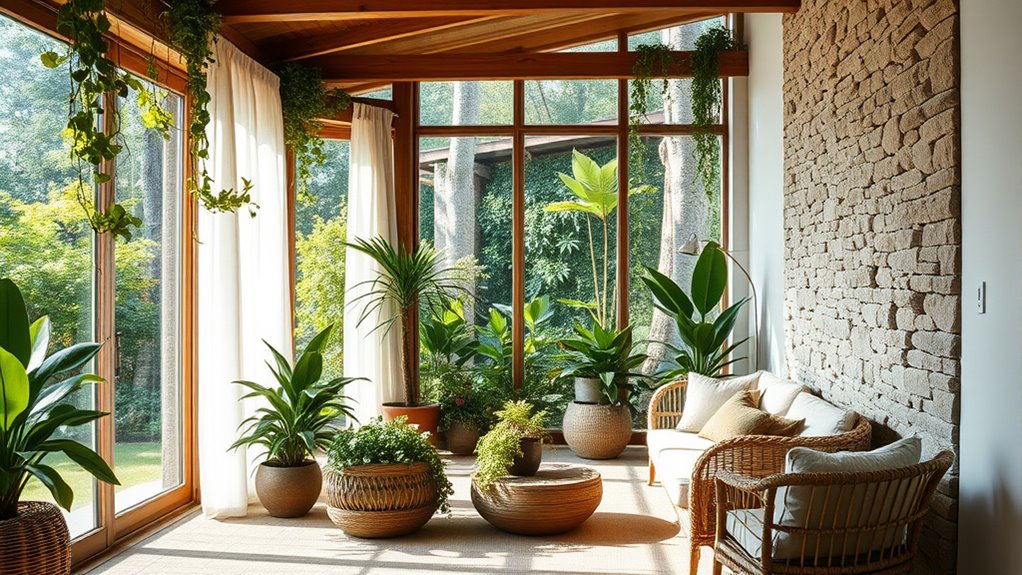
You can enhance your space by carefully choosing window placements that maximize outdoor views. Clear sightlines between indoors and outdoors create a seamless connection, making your environment feel more open. Boost natural light further by selecting strategies that improve daylight flow throughout your home. Incorporating natural light considerations into your design can significantly improve the overall ambiance and energy efficiency.
Window Placement Strategies
Positioning windows thoughtfully can dramatically enhance your connection to the outdoors, bringing natural light and views into your space. Consider window orientation to maximize sunlight and seasonal changes, enhancing comfort and energy efficiency. Larger windows provide expansive views, but balance size with privacy and structural considerations. Proper placement ensures key sightlines to nature and improves daylight distribution. Think about how window size affects brightness and connection, and avoid blocking natural views. Additionally, strategic placement can frame outdoor scenery like trees or gardens, creating a visual link. Incorporating natural light management techniques can further optimize the indoor environment and reduce energy costs.
Indoor-Outdoor Sightlines
Creating strong indoor-outdoor sightlines invites the outdoors into your living space, making it feel more expansive and connected. To achieve this, choose window treatments that frame views without blocking them, like sheer curtains or motorized shades. Consider positioning outdoor furniture strategically to create inviting vistas from inside. When selecting furniture, opt for pieces that complement your view and encourage outdoor engagement. Additionally, ensuring that your visual connections are unobstructed can significantly enhance the biophilic experience.
Natural Light Enhancement
Maximizing natural light is essential for fostering a strong visual connection to the outdoors and enhancing your living space’s openness. To achieve this, consider thoughtful furniture arrangement that avoids blocking windows and allows light to flow freely. Use light-colored, reflective surfaces to amplify brightness, and incorporate sheer curtains or blinds to control glare without sacrificing daylight. Proper acoustic management can also improve the overall atmosphere, making the space feel brighter and more inviting. Position seating to face windows, creating a seamless indoor-outdoor connection. Strategically placing mirrors can reflect sunlight deeper into rooms, increasing natural illumination. Remember, a well-lit space not only enhances visual connection but also boosts mood and comfort. Small adjustments can considerably transform your environment into a luminous, nature-connected sanctuary.
Integrating Water Features and Natural Elements
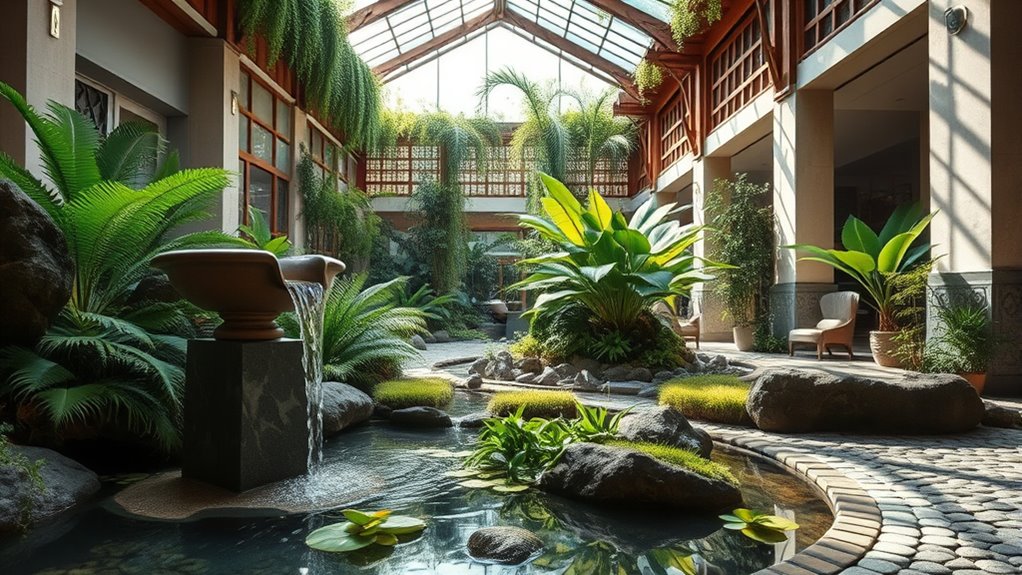
Incorporating water features and natural elements into your design brings a soothing, dynamic energy that enhances the connection to nature. A water garden serves as a focal point, inviting tranquility and visual interest. Use aquatic plants like lilies, reeds, and water hyacinths to add texture, color, and movement. These plants thrive in water gardens, creating a natural habitat that attracts birds and beneficial insects. Incorporate a small fountain or pond to introduce the gentle sound of flowing water, which further relaxes the mind. Natural stones and driftwood can be integrated to reinforce organic aesthetics and provide shelter for aquatic life. By thoughtfully combining these elements, you create a harmonious environment that blurs the boundaries between indoor and outdoor spaces, fostering a vibrant, natural ambiance.
Utilizing Organic Shapes and Patterns
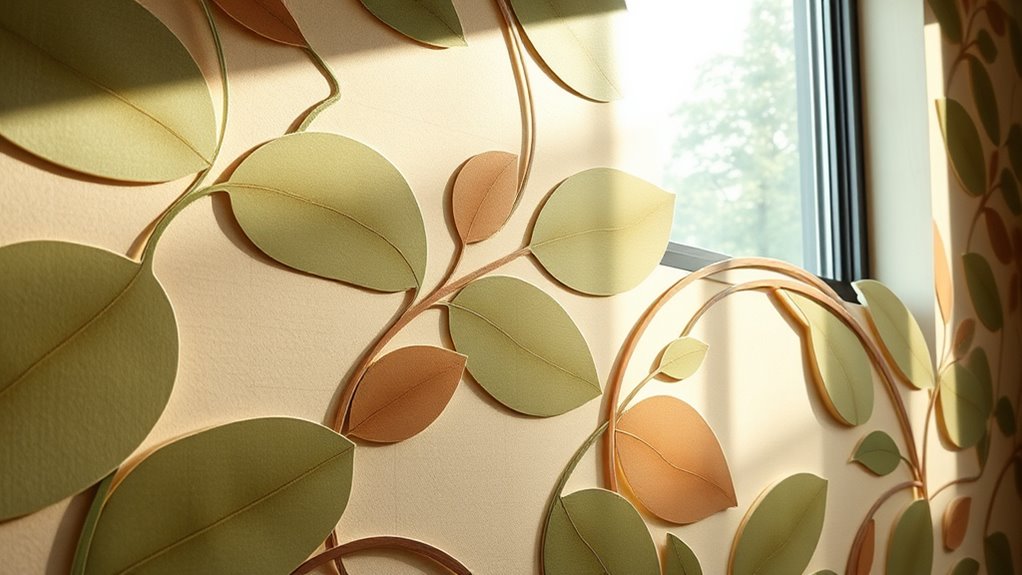
Organic shapes and patterns breathe life into your design by emphasizing natural flow and harmony. They create a sense of movement and softness, making spaces feel more inviting and calming. Incorporating flowing patterns and irregular forms allows you to mimic nature’s effortless beauty. These elements can be applied through curved furniture, leaf-inspired motifs, or textured wall coverings. To deepen your connection to nature, consider:
- Using biomorphic shapes in furniture
- Incorporating leaf or wave patterns
- Choosing materials with organic textures
- Incorporating irregular, flowing lines
- Using natural color palettes to complement shapes
Balancing Minimalism With Nature-Inspired Decor

Blending minimalism with nature-inspired decor creates a harmonious balance that feels both serene and purposeful. To achieve this, select eco-friendly furniture with clean lines and natural materials, avoiding clutter while emphasizing quality. Keep your space simple, focusing on a few statement pieces that evoke nature’s beauty. Incorporate natural scent integration through essential oils or candles that mimic outdoor aromas, enhancing tranquility. Use neutral tones and organic textures to maintain a minimalist aesthetic while adding subtle touches of nature. This approach allows you to enjoy a clutter-free environment that nurtures your well-being. The key is to balance simplicity with nature-inspired elements, creating a space that’s calming, sustainable, and visually connected to the natural world.
Maintaining a Healthy and Sustainable Space
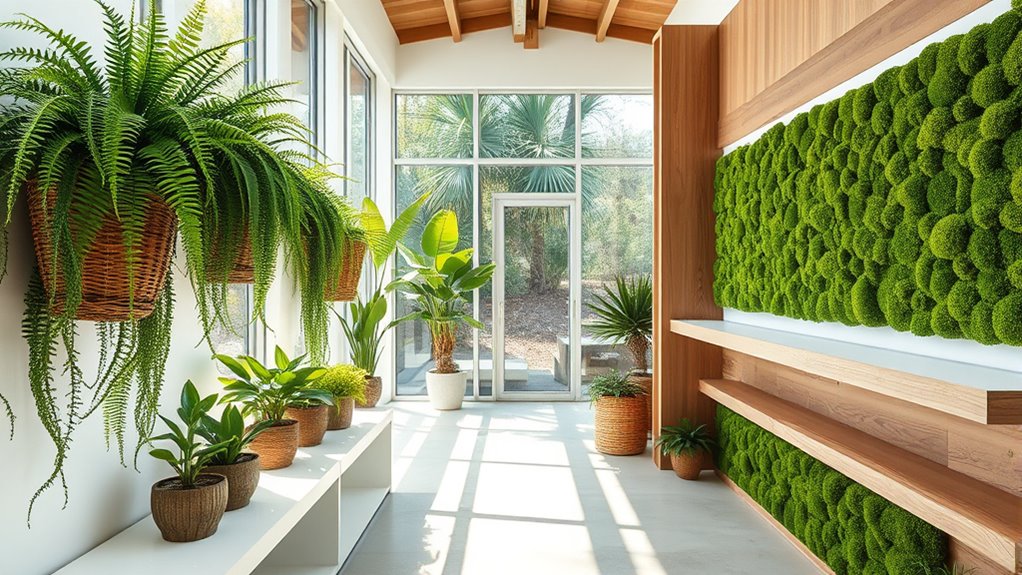
Maintaining a healthy and sustainable space requires intentional choices that support both your well-being and the environment. Embracing biophilic design and sustainable architecture helps you create a harmonious environment that fosters health and reduces ecological impact. To stay on track, consider integrating natural light, using eco-friendly materials, and ensuring proper ventilation. Regularly preserving indoor plants not only improves air quality but also boosts mood. Incorporate energy-efficient appliances and water-saving fixtures to minimize resource consumption. Choosing durable, locally sourced materials supports sustainability. Keep surfaces clean to prevent mold and allergens. By making these conscious decisions, you ensure your space remains healthy, eco-friendly, and aligned with biophilic principles, promoting a balanced lifestyle that respects the planet.
Frequently Asked Questions
How Can Biophilic Design Improve Overall Well-Being?
You might wonder how design impacts well-being. Incorporating natural elements can substantially reduce stress and boost cognitive function. When your environment includes greenery, natural light, and organic textures, you’ll feel calmer and more focused. This connection to nature enhances mental clarity and emotional stability. By integrating these features into your space, you create a healthier, more inviting atmosphere that actively supports your overall well-being.
What Are Budget-Friendly Ways to Incorporate Nature-Inspired Elements?
Thinking you need a lush rainforest to feel connected to nature? Think again. You can easily boost your space with budget-friendly DIY decor made from recycled materials—think planters from old jars or wall art from reclaimed wood. These simple, cost-effective touches bring the outdoors inside without breaking the bank, proving that nature-inspired design doesn’t have to be expensive or complicated. Just get creative and let nature do the rest.
Can Biophilic Principles Be Applied in Small or Urban Spaces?
You can definitely apply biophilic principles in small or urban spaces by adding urban greenery like potted plants, vertical gardens, or window boxes. Small-scale biophilia enhances your environment, making it feel more natural and calming. Focus on maximizing natural light, incorporating natural materials, and creating views of nature. Even limited space can become a soothing retreat by thoughtfully integrating these elements, transforming your urban setting into a calming, nature-inspired haven.
How Do Color Choices Influence Mood and Productivity?
Imagine your workspace as a canvas; color choices are your brushstrokes. You might think vibrant reds boost energy, but they can also increase stress. Color psychology shows cool blues promote calm and focus, enhancing productivity. Bright yellows spark creativity, while soft greens reduce anxiety. By selecting colors thoughtfully, you influence mood and productivity, transforming your space into an environment that energizes or soothes, depending on your needs.
What Maintenance Is Required for Natural Materials and Plants?
You need to regularly maintain natural materials and plants through natural cleaning methods to prevent dirt buildup and pests. Seasonal care is essential; for example, watering appropriately, pruning, and adjusting light exposure depending on the season. Keep an eye on humidity levels and avoid harsh chemicals to preserve their integrity. By staying consistent with these practices, your natural elements stay healthy, vibrant, and beautiful, enhancing your space effectively.
Conclusion
By embracing biophilic design, you blend the serenity of nature with the comfort of your space, turning walls into lush forests and rooms into peaceful retreats. Imagine sunlight pouring in, highlighting natural textures, while vibrant greenery breathes life into every corner. This balance of organic shapes and sustainable choices creates a sanctuary that’s both invigorating and calming. Ultimately, you craft an environment where nature’s beauty and your well-being harmoniously coexist, transforming your space into a living, breathing masterpiece.
